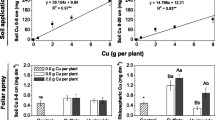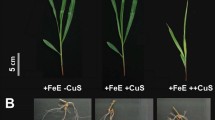Abstract
The application of herbicides has induced symptoms of nutrient deficiencies under some circumstances. This glasshouse study examined the effect of chlorsulfuron on the uptake and utilization of copper (Cu) in four cultivars of wheat plants (Triticum aestivum L. cvs. Kulin, Cranbrook, Gamenya and Bodallin) on a Cu-responsive soil. Application of chlorsulfuron depressed the concentration of Cu in wheat plants receiving either inadequate or adequate Cu. In plants with inadequate Cu supply, chlorsulfuron increased the severity of Cu deficiency. Shoot weight was markedly decreased by chlorsulfuron at all levels of Cu, through decreasing the number of tillers and the elongation of leaves. This decreased growth of shoots occurred prior to the effect on Cu concentration in tissues. The retranslocation of Cu in old tissues over time was unaffected by chlorsulfuron. In all wheat cultivars, the decreased growth of shoots were correlated with the concentration of Cu in the youngest fully emerged leaf blade with critical levels of 1.6−1.7 at day 25 and 0.9−1.0 µg g−1 d. wt. at day 60. The application of chlorsulfuron tended to increase the critical level at day 25 but not at day 60. In addition, Kulin seems to be most, and Cranbrook least, sensitive to chlorsulfuron. This sensitivity was associated with the sensitivity of the cultivars to Cu deficiency. It is suggested that chlorsulfuron application induces Cu deficiency in wheat plants mainly due to effects on the uptake of Cu.
Similar content being viewed by others
References
Beyer E M, Duffy MJ, Hay J V and Schlueter D D 1988 Sulfonylureas. In Herbicides: Chemistry, Degradation and Mode of Action. Eds P C Kearney and D D Kaufman. pp. 117–89. Marcel Dekker, New York.
Bowran D G 1986 Tolerance of cereal crops to herbicides. J. Agric. Western Australia 1, 14–17.
Bowran D G 1990 The tolerance of six wheat cultivars to chlorsulfuron and triasulfuron in Western Australia. In Proceedings of the Ninth Australian Weeds Conference. pp 65–7. Adelaide.
Bowran D G and Blacklow W M 1987 Sensitivities of spring wheat cultivars to chlorsulfuron were measured as inhibitions of leaf elongation rates and there were genotype × environment interactions. Aust. J. Agric. Res. 38, 253–262.
Bowran D G, Porritt S and Madin R 1987 Chlorsulfuron and diclofop-methyl effects on the copper and zinc status and yield of wheat. In Proceedings of the Ninth Australian Weeds Conference. pp 404–6. Sydney.
Brennan R F, Gartrell J W and Robson A D 1980 Reactions of copper with soil affecting its availability to plants. I Effects of soil type and time. Aust. J. Soil Res. 18, 447–459.
Dong B, Rengel Z and Graham R D 1995 Effects of herbicide chlorsulfuron on growth and nutrient uptake parameters of wheat genotypes differing in Zn-efficiency. Plant Soil 173, 275–282.
Fredrickson D R and Shea P J 1986 Effect of soil pH on degradation, movement and plant uptake of chlorsulfuron. Weed Sci. 34, 328–332.
Graham R G and Nambiar E K S 1981 Advances in research on copper deficiency in cereals. Aust. J. Agric. Res. 32, 1009–1037.
Hill J, Robson A D and Loneragan J F 1978 The effect of copper and nitrogen supply on the retranslocation of copper in four cultivars of wheat. Aust. J. Agric. Res. 29, 925–939.
O'Connell A M and Grove T S 1987 Seasonal variation in C2H2 reduction (N2) fixation in the litter layer of eucalypt forest of south western Australia. Soil Biol. Biochem. 19, 135–142.
Osborne L D and Robson A D 1992 Duration of zinc uptake inhibition by chlorsulfuron in wheat. Aust. J. Agric. Res. 43, 1169–1174.
Osborne L D, Robson A D and Bowran D G 1993 The impact of chlorsulfuron and diclofop-methyl on nutrient uptake by wheat. Aust. J. Agric. Res. 44, 1757–1766.
Ray T B 1982 The mode of action of chlorsulfuron: a new herbicide for cereals. Pesticide Biochem. Physiol. 17, 10–17.
Robson A D and Snowball K 1989 The effect of 2-(4-(2'4'dichlorophenoxy)-phenoxy)-methyl propanoate on the uptake and utilization of zinc by wheat. Aust. J. Agric. Res. 40, 981–990.
Robson A D and Snowball K 1990 The effect of chlorsulfuron on the uptake and utilization of copper and zinc in wheat. Aust. J. Agric. Res. 41, 19–28.
Simmons W J 1978 Background absorption error in determination of copper in plants by flame atomic absorption spectrometry. Anal. Chem. 50, 870–873.
Wheal M, Rengel Z. and Graham R D 1998 Chlorsulfuron reduces extension of wheat root tips in low-zinc solution culture. Ann. Bot. 81, 385–389.
Author information
Authors and Affiliations
Rights and permissions
About this article
Cite this article
Tang, C., Robson, A.D. Cultivar variation in the effect of chlorsulfuron in depressing the uptake of copper in wheat. Plant and Soil 225, 11–20 (2000). https://doi.org/10.1023/A:1026598918181
Issue Date:
DOI: https://doi.org/10.1023/A:1026598918181




